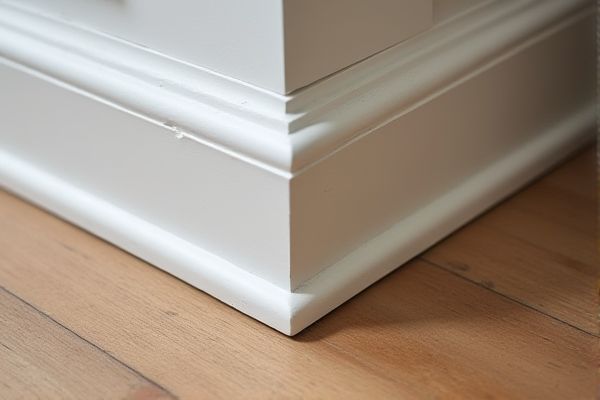
Toe kicks provide essential ergonomic space beneath kitchen cabinets, allowing easier access and comfort during prolonged standing, whereas furniture bases offer a decorative finish that enhances the aesthetic appeal by covering the cabinet's bottom edges. To understand which option best suits Your kitchen design and functionality needs, continue reading the rest of the article.
Table of Comparison
| Feature | Toe Kick | Furniture Base |
|---|---|---|
| Definition | Recessed area at the base of cabinets for foot space. | Full base panel supporting furniture, flush with floor. |
| Function | Provides ergonomic foot space for comfort while standing. | Offers structural support and aesthetic finish. |
| Installation | Integrated under cabinets, typically 3-4 inches high. | Attached as a solid base, often covers cabinet bottom. |
| Design Impact | Creates floating effect, enhances usability. | Gives grounded, solid appearance to furniture. |
| Maintenance | Easier to clean underneath due to gap. | May trap dust, harder to clean under furniture. |
| Common Use | Kitchen cabinets, built-in cabinetry. | Freestanding furniture, dressers, cabinets. |
Introduction to Toe Kick and Furniture Base
A toe kick is a recessed space at the bottom of kitchen cabinets designed to provide ergonomic comfort by allowing your feet to fit underneath the cabinetry while standing. The furniture base, contrastingly, is a decorative panel that covers the cabinet toe kick area, enhancing the aesthetic appeal by creating a seamless look with the rest of the furniture. Understanding the difference helps you choose between practical functionality and visual style for your kitchen design.
Definition of Toe Kick
A toe kick is a recessed area at the bottom of kitchen cabinets or furniture that allows space for toes, preventing users from stubbing their feet while standing close to the surface. Unlike a furniture base, which is the support structure or visible bottom panel of a piece, the toe kick creates ergonomic clearance and enhances comfort during use. This recessed design typically measures about 3 to 4 inches high and 3 inches deep, optimizing both functionality and aesthetic integration in cabinetry.
Definition of Furniture Base
A furniture base is the visible panel at the bottom of cabinets or furniture pieces that conceals the support structure and provides a finished look, often matching the cabinetry style or material. In contrast to a toe kick, which is recessed to allow your feet space while standing close to the furniture, the furniture base sits flush with the floor, emphasizing seamless design rather than ergonomic function. Understanding the definition of a furniture base helps you choose the right style for both aesthetics and usability in your space.
Key Design Differences
Toe kicks are recessed sections at the bottom of cabinets designed to provide ergonomic foot space, typically measuring 3-4 inches high and 3 inches deep. Furniture bases extend to the floor without recess, offering a continuous vertical surface that enhances the aesthetic of freestanding furniture. Toe kicks improve comfort and functionality in kitchen cabinetry, while furniture bases prioritize style and seamless integration with surrounding decor.
Functional Benefits of Toe Kicks
Toe kicks provide ergonomic comfort by creating space for your feet when standing close to cabinets, reducing strain during kitchen tasks. Unlike furniture bases, toe kicks enhance accessibility and support better posture, making prolonged activities more comfortable. Their recessed design also protects the cabinet base from damage while facilitating easier cleaning beneath the cabinetry.
Functional Benefits of Furniture Bases
Furniture bases provide enhanced structural support and stability compared to traditional toe kicks by evenly distributing weight across the cabinet base. They enable easier cleaning and maintenance by eliminating gaps beneath cabinets where dust and debris typically accumulate. The elevated height of furniture bases also allows for seamless integration with surrounding flooring and improved ergonomic comfort during use.
Aesthetic Impact on Kitchen and Cabinetry
Toe kicks create a recessed base that enhances kitchen cabinetry's clean lines and adds depth, promoting a sleek and modern aesthetic. Furniture bases offer a continuous, flush appearance that can make cabinetry look more integrated and custom-built, ideal for traditional or high-end designs. Your choice between toe kick and furniture base affects the visual weight and style of the kitchen, influencing overall spatial perception and flow.
Installation Methods Compared
Toe kicks are typically installed as part of the cabinet assembly, secured with screws or adhesive directly to the base, providing easy access for cleaning under furniture. Furniture bases, often pre-made and attached separately, require precise measurement and can be mounted using brackets or brackets combined with glue for stability. Understanding these installation methods helps you choose the best option based on your kitchen design and maintenance preferences.
Cost and Maintenance Considerations
Toe kicks generally offer a more cost-effective solution compared to furniture bases, as they require less material and simpler installation. Maintenance for toe kicks is minimal, with easy cleaning access underneath cabinets that reduces dust accumulation. Furniture bases, while visually appealing, often incur higher costs due to additional materials and labor, and their maintenance can be more intensive to preserve decorative finishes.
Choosing the Right Option for Your Space
Choosing between a toe kick and a furniture base depends on your space's design and functionality needs. A toe kick provides ergonomic comfort, allowing your feet to fit under cabinets for ease of use, while a furniture base offers a sleek, seamless appearance that suits modern or custom cabinetry. Evaluate how you use your space to determine whether comfort or aesthetics should guide your choice.
 homyna.com
homyna.com